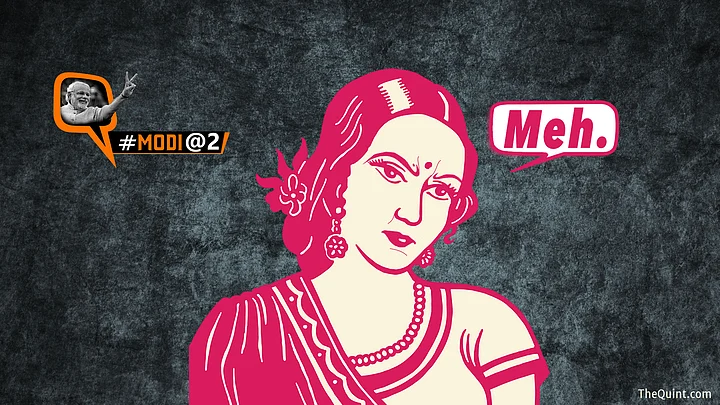Slogans tend to have a short shelf life. Election slogans, even more so.
During the 2014 General Elections, one of BJP’s most popular slogans revolved around women’s safety. “Bahut hua naari par atyaachaar, ab ki baar Modi sarkar!” was a constant refrain heard on the airwaves, seen on billboards and advertised in newspapers. Ensuring women’s safety and drafting policies for women was one of the major planks on which the current NDA government fought (and won) the elections.
But, two years later, what are the policies implemented by the Modi sarkar for women, and what has been the impact of these initiatives?
Has ‘women’s empowerment’ been a priority focus for the government or has it been relegated to a dusty, election slogan, well past its expiry date?
The Curious Case of Nirbhaya Rape Crisis Centres
In July 2014, the NDA government announced that it will establish 660 Nirbhaya Rape Crisis centres all over the country. These centres – offering legal help to file FIRs, medical assistance where the rape survivors would be referred to a hospital and counselling services – were supposed to be a one-stop crisis centre for rape survivors.
But, were. Past tense.
That’s because in February 2015, the government cut down the number of rape crisis centres from 660 to 36, one in every state and Union territory. Alongside, the funding for these centres was cut down from Rs 244.8 crores to a paltry Rs 18 crores. In a country with a severe lack of trauma infrastructure for a rape survivor, the sudden turnaround by the government has been criticised by activists and the public alike.
The cut in funding would have made fiscal sense, if the government was short of funds to spend on women’s safety.
However, it really wasn’t.
It has been reported in 2016, that the Nirbhaya fund, constituted by the UPA government has been lying unused despite many proposals by the Women and Child development ministry to utilise it. In 2013, the fund had Rs 1,000 crore, and the amount increased after Finance Minister Arun Jaitley announced an additional Rs 200 crore.
The budget for the Nirbhaya Rape Crisis centres was supposed to be drawn from this fund. Why, then, was there a cut in the budget?
Beti Bachao, Beti Padhao: A Step in the Right Direction
‘Beto Bachao, Beti Padhao’ was launched in January 2015. Aimed at combating low child sex ratio in 100 critical districts, the scheme was expanded to 61 more districts in April 2016 – but has maximum recall value because of the viral ‘Selfie with Daughter’ hashtag campaign.
However, hashtags are not what the initiative is only about. In the districts in which the scheme is implemented, it works in two ways.
One, coordinated action at the district which involves registering pregnancies to avoid female foeticide, strict implementation of the Pre-Conception and Pre-Natal Diagnostic Techniques (PCP&DT) Act and the Right to Education (RTE) Act and constructing functional toilets for girls, among others. Two, mass communication strategies aimed at gender sensitisation and awareness.
And while the new sex ratio figures aren’t expected until 2021, according to NGOs working on the ground in the BBBP districts, the scheme has had a positive impact.
In critical child sex ratio districts like Mahendragarh, Jhajjar and Gurugram where BBBP is implemented, we have seen an upward mobility. According to me, if the efforts in the scheme are continued with the same intensity, there would be an overall positive impact.Ranjana Kumari, Director, Centre for Social Research
But challenges remain.
While the ‘Beti Bachao’ part of the campaign has had positive gains, ‘Beti Padhao’ has not been focused on with the same fervour. Or worse, has been confused with overlapping programs.
Similarly, at the grassroots level it has been reported that due to the existence of the purdah system, most anganwadi workers find it difficult to involve male members of the community in the awareness programs.
More Funds for Panchayati Raj, But Less Women?
At the outset, the figures indicate good news for the Panchayati Raj institution. However, for the Panchayats to succeed, fiscal devolution has to be matched with a devolution of political power.
For women in Panchayati Raj, has the current NDA government strengthened their position? Or have the steps it has taken undermined it?
In September 2015, the BJP led-Haryana assembly passed the Haryana Panchayati Raj (Amendment) Act, 2015 which fixed minimum educational qualification for elections to the Panchayati Raj institutions. Women candidates would now have to pass Class 8, a decision which has led to 68 percent of Scheduled Caste (SC) women becoming ineligible to contest elections. A similar law has been passed in BJP-led Rajasthan which has disqualified around 98 percent of SC women in the state.
This has led to an exclusion of women in governance at a local level, even if these steps have been taken at the State level. The NDA government has time and again reiterated the importance of the Panchayati Raj system to democratic spirit in India, and especially the role of women in the Panchayat.
Panchayat to Parliament is more like a slogan, than a real devolution of power. Many states haven’t devolved power to the panchayat. And rather than doing that, the NDA government is focused on electing panchayats on the basis of educational levels. The local government was supposed to be the third tier of government, but the government wants them to work as agents of the State government.Ash Narain Roy, Director, Institute of Social Sciences
If there are fewer and fewer women in Panchayati Raj, how will fiscal devolution alone strengthen the institution? Even if the charge of these Amendments cannot be lawfully put at the NDA government’s door, the mismatch in its ‘Panchayat to Parliament’ slogan and the ground reality of women in Panchayati Raj is explicit – and a difference which the NDA government needs to take responsibility for.
(At The Quint, we question everything. Play an active role in shaping our journalism by becoming a member today.)
